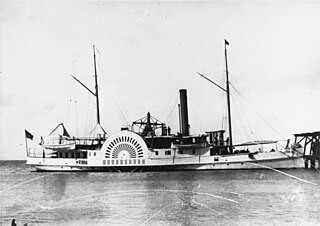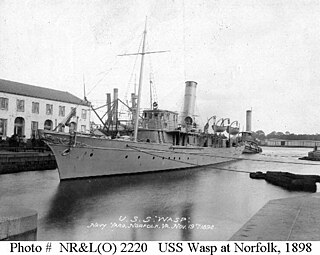
The first USS Dixie was a United States Navy auxiliary cruiser and later a destroyer tender. The Dixie was the first ship of the United States Navy to have this name.

The first USS Panther (AD-6), the former SS Venezuela, was an auxiliary cruiser and naval troop transport in the United States Navy.

USS Algonquin, completed as El Toro in 1891 for the Southern Pacific Railroad's Morgan Line, was a small harbor tug commissioned by the United States Navy 2 April 1898. Renamed Accomac, after Accomac, Virginia, June 1898, renamed Nottoway in 1918 and, after the Navy adopted alphanumeric hull numbers on 17 July 1920, classified as YT-18, a district tug. On 5 October 1942 the name was cancelled and the tug was simply YT-18 until 1944 when classification was changed to YTL-18, a little harbor tug. Over the years as a Navy tug, from 1898 to 1946, the tug served from Cuba to Boston.

USS Helena (PG-9) was a Wilmington-class gunboat of the United States Navy. She participated in the Spanish–American War, and served in the Far East for many years. The (PG-9) was the first of five Navy vessels named after the capital city of Montana.

The Battle of Tayacoba, June 30, 1898, was an American special operations effort to land supplies and reinforcements to Cuban rebels fighting for their independence in the Spanish–American War.
Sea Gull was a steamship in the United States Navy. She was the second steamship of the United States Navy and the first to serve actively as a warship.

The first USS Solace (AH-2) was a hospital ship in the United States Navy.

The first USS Annapolis (PG-10/IX-1) was a gunboat in the United States Navy. She was named for Annapolis, Maryland.

The second USS Amphitrite—the lead ship in her class of iron-hulled, twin-screw monitors—was laid down, on June 23, 1874 by order of President Ulysses S. Grant's Secretary of Navy George M. Robeson at Wilmington, Delaware, by the Harlan and Hollingsworth yard; launched on 7 June 1883; sponsored by Miss Nellie Benson, the daughter of a Harlan and Hollingsworth official; and commissioned at the Norfolk Navy Yard, Portsmouth, Virginia, on 23 April 1895, Captain William C. Wise in command.

USS Porter was a torpedo boat, the first of her class, launched in 1896, served during the Spanish–American War, and struck in 1912. She was the first Navy ship named for Commodore David Porter, and his son, Admiral David Dixon Porter.

USS Topeka (PG-35) was a gunboat of the United States Navy.

USS Sandoval (1895) was an Alvarado-class gunboat acquired by the United States Navy from the Spanish as a prize-of-war. Duties assigned her by the Navy included patrolling coastal and river waterways, and, later, acting as a "practice ship" for the United States Naval Academy at Annapolis, Maryland and for the New York Naval Militia as well.

USS Vulcan (1884) was an iron-hulled, schooner-rigged screw steamship acquired by the U.S. Navy for use as a repair ship during the Spanish–American War.

USS Delaware (1861) was a steamer acquired by the Union Navy for use during the American Civil War. She had a very active naval career as a gunboat for over three years, and after the war served as a revenue cutter for over 37 years. The steamer was sold to the private sector in 1909, and disappeared from shipping registers in 1919.
USS Sunflower (1863) was a 294-ton steamer acquired by the Union Navy during the American Civil War.

The seventh USS Wasp was the former yacht Columbia, purchased by the U.S. Navy and converted to an armed yacht serving from 1898 to 1919, with service in the Spanish–American War and World War I.

The Third Battle of Manzanillo was a naval engagement that occurred on July 18, 1898, between an American fleet commanded by Chapman C. Todd against a Spanish fleet led by Joaquín Gómez de Barreda, which occurred during the Spanish–American War. The significantly more powerful United States Navy squadron, consisting of four gunboats, two armed tugs and a patrol yacht, overpowered a Royal Spanish Navy squadron which consisted of four gunboats, three pontoon used as floating batteries and three transports, sinking or destroying all the Spanish ships present without losing a single ship of their own. The victory came on the heels of a more significant American success at the Battle of Santiago de Cuba, and was the third largest naval engagement of the war after Santiago de Cuba and the Battle of Manila Bay.

SS Yorktown was launched February 10, 1894, by Delaware River Iron Ship Building and Engine Works, Chester, Pennsylvania for the Old Dominion Steamship Company for the company's overnight New York City/Norfolk, Virginia service. The United States Navy purchased Yorktown on April 21, 1898, to be commissioned as the second USS Resolute, an auxiliary cruiser and transport that saw naval service during the Spanish–American War 1898–1899. The United States Department of War acquired the ship on January 22, 1900, for service as the United States Army Transport (USAT) Rawlings. The ship was sold to the Merchants and Miners Transportation Company of Baltimore, Maryland on July 27, 1901, and renamed Powhatan. Powhatan was wrecked in 1916 and in 1919 rebuilt as the world's first turbo-electric propelled passenger ship Cuba for luxury passenger and express freight service between Florida and Cuba with the Miami Steamship Company beginning service in 1920. Renamed Seneca, the ship burned and sank December 30, 1927, at Hoboken, New Jersey then refloated September 2, 1928, and scrapped.

City Ice Boat No. 3, commonly known as Ice Boat No. 3 or just No. 3, was a municipal sidewheel icebreaker built in 1873 to assist in keeping Philadelphia's waterways free of ice during the winter months. The vessel was also used for occasional excursions and other duties through the rest of the year.

USS Wompatuck (YT-27) was an armed tug in commission in the United States Navy from 1898 to 1931. Early in her naval career, she saw combat in the Spanish–American War and the Philippine–American War. After she was decommissioned, she was selected for conversion into the fuel oil barge YO-64, but she was lost in the early days of World War II in the Pacific before the conversion could be completed.

















